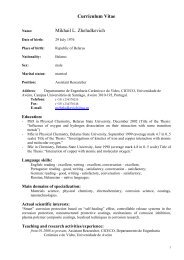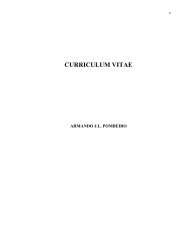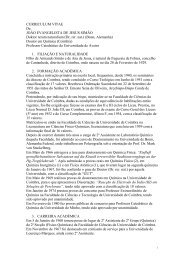XII Iberian Meeting of Electrochemistry XVI Meeting of the ...
XII Iberian Meeting of Electrochemistry XVI Meeting of the ...
XII Iberian Meeting of Electrochemistry XVI Meeting of the ...
Create successful ePaper yourself
Turn your PDF publications into a flip-book with our unique Google optimized e-Paper software.
<strong>XII</strong> <strong>Iberian</strong> <strong>Meeting</strong> <strong>of</strong> <strong>Electrochemistry</strong> & <strong>XVI</strong> <strong>Meeting</strong> <strong>of</strong> <strong>the</strong> Portuguese Electrochemical Society PC 04<br />
Electrochemical control on <strong>the</strong> formation <strong>of</strong> mixed 11-<br />
mercaptoundecanoic acid and octanethiol self-assembled<br />
monolayers on Au(111)<br />
Zoilo González-Granados, Rafael Madueño, Manuel Blázquez, Teresa Pineda<br />
Dpto. Química Física y Termodinámica Aplicada, Universidad de Córdoba, Córdoba, SPAIN<br />
tpineda@uco.es<br />
Self assembled monolayers (SAMs) <strong>of</strong> terminal-functionalized alkanethiols are less<br />
organized structures than <strong>the</strong>ir alkanethiol partner monolayers. The bigger size <strong>of</strong> <strong>the</strong><br />
terminal group and/or <strong>the</strong> repulsive interactions between equally charged groups are<br />
mostly responsible for this disorder. One strategy that can be followed in order to have a<br />
better organized monolayer is <strong>the</strong> dilution <strong>of</strong> <strong>the</strong> functional groups by using a mixed<br />
monolayer with a determined ratio <strong>of</strong> <strong>the</strong> alkanethiol. In this sense, <strong>the</strong> mixed<br />
monolayers can show ei<strong>the</strong>r a homogeneous<br />
distribution <strong>of</strong> <strong>the</strong> molecules with different<br />
chemical nature or a phase separated behaviour.<br />
Any <strong>of</strong> <strong>the</strong>se properties are useful depending on <strong>the</strong><br />
applications.<br />
In this work, we present a study <strong>of</strong> <strong>the</strong> mixed<br />
monolayer formed from 11-mercaptoundecanoic<br />
acid (MUA) and octanethiol (OT) at different<br />
MUA/OT molar ratios. Taking advantage <strong>of</strong> <strong>the</strong><br />
different electrochemical behaviour <strong>of</strong> <strong>the</strong>se two<br />
molecules on an Au(111) single crystal electrode<br />
(Figure 1), we prepare <strong>the</strong>se monolayers under<br />
electrochemical control from an alkaline aqueous<br />
solution [1].<br />
Figure 1. Cyclic voltammetry <strong>of</strong> 1 mM MUA and 1<br />
mM OT in 0.1 M NaOH aqueous solution on a<br />
Au(111) single crystal electrode.<br />
The differences between <strong>the</strong> oxidation (deposition)<br />
and reduction (desorption) potentials for <strong>the</strong>se two<br />
monolayers can serve as a way <strong>of</strong> quantification <strong>of</strong> <strong>the</strong> composition <strong>of</strong> <strong>the</strong> mixed MUA-<br />
OT layer obtained not only by potentiodynamic but also by potentiostatic methods.<br />
Acknowledgments: Project CTQ2007/62723, Junta de Andalucía and Universidad de Córdoba.<br />
References<br />
[1] García Raya, D.; Madueño, R.; Blázquez, M.; Pineda, T.; J. Phys. Chem. C, 2010, 114, 3568.<br />
September, 811, 2010. ISEL - Lisbon 82








